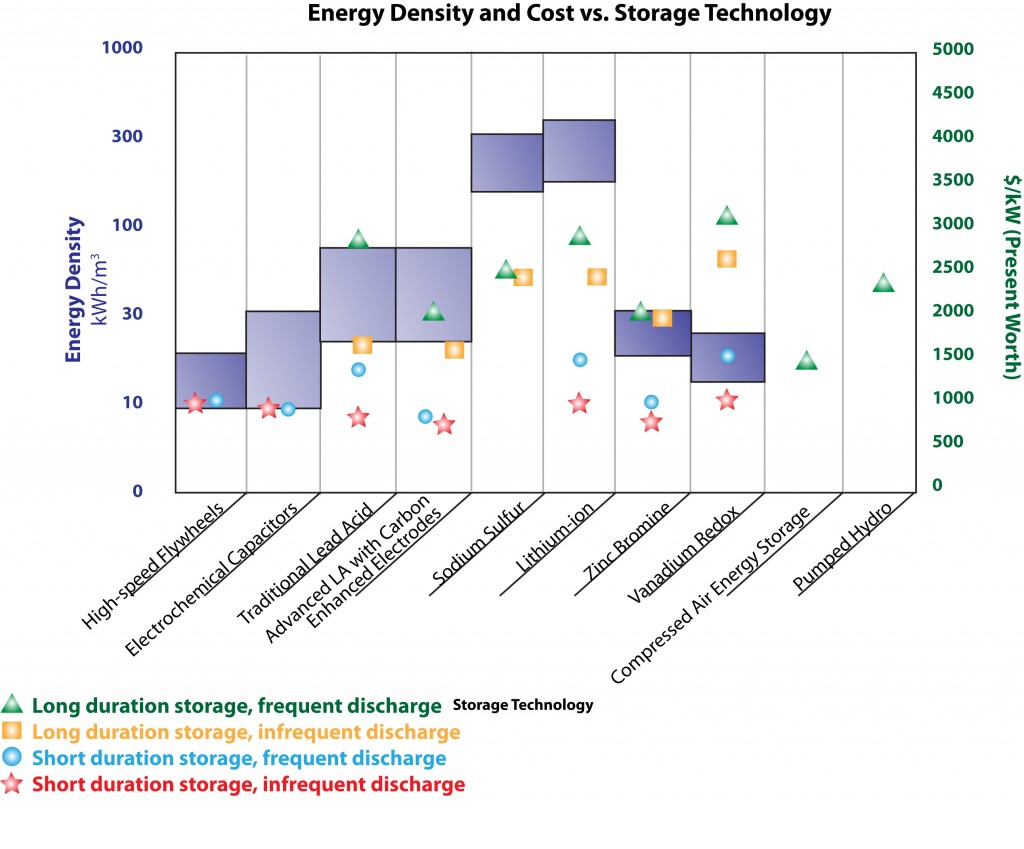Our December 12th post introduced the importance of energy storage; today, we take a deeper look at where innovation is needed and the technologies that make it all possible.
Energy storage technology: more than just batteries
When we mention energy storage, your phone and computer batteries are likely the first technologies to come to mind; AA batteries are probably a close second. This is because they’ve become such a daily part of our lives. In energy storage technology, these are just the tip of the iceberg.
Energy storage systems vary greatly by their storage capacity, discharge time, power quality, and energy management. There are many different types of systems, including mechanical, fluid, thermal, and electrochemical. In general, electrochemical systems are the most common types of energy storage – they include basic batteries (such as lead-acid car batteries or lithium-ion phone batteries) as well as super capacitors and fuel cells. Mechanical storage systems, such as flywheels, and fluid storage systems, such as compressed air energy storage, are quite common but rely on a few tried and true technologies for a limited number of applications.

There are many types of thermal, mechanical, fluid, and electrochemical systems out there, but there’s room for improvement. As consumer electronic, mobile, and energy technologies begin to outpace the capacities of their energy storage counterparts, we’ll need innovation in energy storage systems. Electrochemical systems in particular are omnipresent and have the most potential. In addition, creative distribution models and smart energy management could revolutionize energy storage.
Limitations and the need for innovation
We frequently see the limitations of energy storage holding other technologies back. Consider the lithium-ion battery (Li-I), an electrochemical system and the most common phone and computer battery: with the advent of smartphones, there has been a perceived decline in performance of most Li-I batteries. This is due to the increasing power demands of modern day electronics: 3G and 4G data processing, bright LED screens, etc. The increasing energy requirements have far outstripped the increase in storage capabilities. Although Li-I batteries have declined in cost over the last ten years (see McKinsey Report here), they are still fairly expensive, especially in emerging markets, and keep the costs of smartphones high. In short, Li-I batteries aren’t keeping pace with the power demand of smaller and faster smart technologies, and as a result, stall their widespread adoption around the world.
Another example of energy storage limiting the application of other technologies is with solar home systems (SHSs). SHSs are almost always accompanied with batteries to help provide continuous electricity, even when the sun isn’t shining. These batteries, too, are commonly electrochemical systems such as lead acid or lithium-ion phosphate. The cost of such batteries drives up the entire cost of the system, often making it unaffordable for customers who could benefit from the technology the most. Worse, the battery itself often needs to be maintained and/or replaced several times through the lifetime of the whole system, which is a serious inconvenience, an additional expense, and potentially damaging if done incorrectly.
Such limitations of energy storage systems are holding back the effectiveness of emerging technologies. This holds true in emerging markets in particular, where the importance of energy storage is critical, but the individuals’ ability to pay is limited. It’s a tall order but we continue to look for low cost systems with increased energy efficiency, portability, and overall lifetime. The following section discusses innovation we’ve seen in electrochemical solutions as well as in distribution and smart management models that are overcoming these limitations.
Innovative startups working to overcome the limitations
Many innovators are already working to close the gaps in energy storage. Innovation today is not only improving Li-I batteries, but also developing other electrochemical technologies and exciting management applications. Prieto Battery, the lithium-ion battery innovation of a Colorado State professor, boasts a five-minute charge time that lasts five times longer than a standard battery. A South African firm, AEDC has developed a new type of fuel cell that relies on zinc air and leaves a minimal impact on the environment. GELI, a Greenstart company, develops software to make batteries smart for the smart grid. GELI’s Energy Operating System (EOS) adds value to energy storage by intelligently managing energy on the grid for multiple value streams.
Of course, no energy storage technology is without its flaws. Some are too expensive while some require careful maintenance. Sometimes, distribution models like that of EGG-energy make the biggest difference in increasing access to energy. EGG’s business model enables users to purchase a battery and trade it in for a fully charged one as needed, typically every 5-7 days. This removes the maintenance burden and allows customers to choose from a variety of battery products as needed.
Ultimately, a combination of smart business models and innovative technologies will enhance the way we use energy around the world. Whether it’s increasing energy efficiency or simply ensuring accessibility when required, energy storage is an exciting space for social entrepreneurs seeking to decentralize energy and overcome existing limitations.
What other companies are working on energy storage innovations, particularly those with emerging markets in mind? Let us know in the comments, or if you’re an entrepreneur, apply.
New here?
- Learn about what we do.
- Follow us on Twitter.
- Like us on Facebook.
- Join us on LinkedIn.
- Sign up for our mailing list.
- Catch up on past Weekly Reviews.
- Got an alternative energy or mobile tech startup for emerging markets? Apply.
